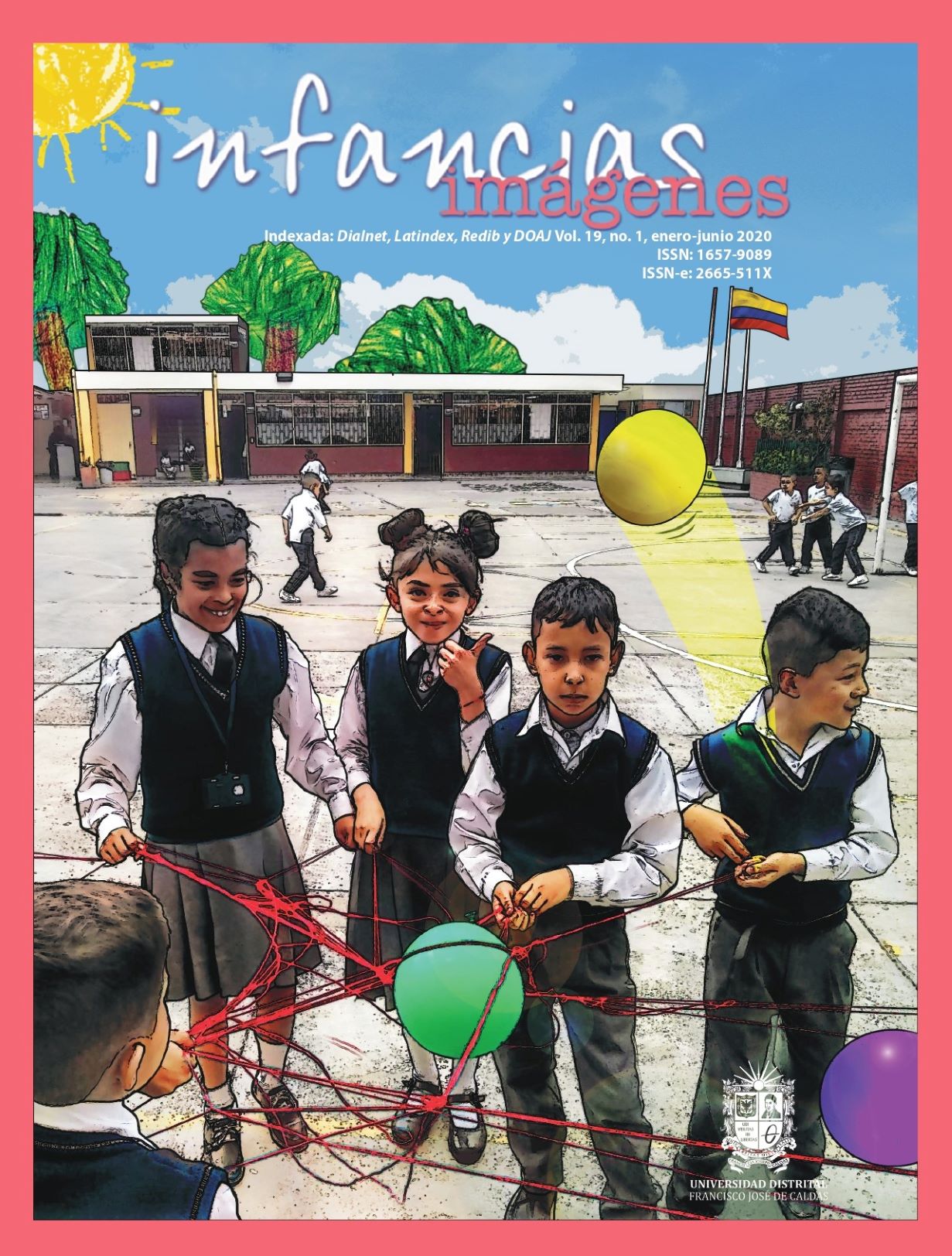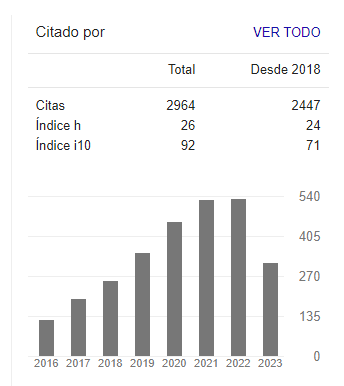DOI:
https://doi.org/10.14483/16579089.13989Publicado:
2020-05-31Número:
Vol. 19 Núm. 1 (2020): enero-junioSección:
Imágenes de InvestigaciónConstrucción del número desde el constructivismo radical y la teoría de Steffe: el caso de Ana
Palabras clave:
numeración, procesos de aprendizaje, teoría educacional, cognición, coordinación de unidades, modelo (es).Descargas
Resumen (es)
Tomando la teoría más representativa del constructivismo radical en educación matemática se realizó un estudio de caso en el que se dirigieron y analizaron tres entrevistas semiestructuradas a Ana, una niña de ocho años, para identificar su pensamiento matemático respecto al número. Mediante los esquemas y operaciones mentales de Steffe se identificó el progreso del pensamiento de la niña, caracterizado a través de sus técnicas para procesar el conteo. El estudio permitió ubicarla en la secuencia numérica tácitamente articulada (SNT) de Steffe. Algunos resultados presentados a partir del análisis de las transcripciones de las entrevistas son: la niña comprende los números como unidades compuestas abstractas, puede coordinar al menos dos niveles de unidades y, puede contar de a dos y de a tres entendiendo tales números como unidades compuestas abstractas; por lo que se concluye su nivel de SNT.
Referencias
Brooks, J. J. G. y Brooks, M. G. (1999). In search of understanding: The case for constructivist classrooms. Association for Supervision and Curriculum Development, 1-DOI: 10.1007/s13398-014-0173-7.2
Camargo, L. (2011). El legado de Piaget a la didáctica de la geometría. Revista Colombiana de Educación, 60, 41-60.
Coello, M. T. (1991). El proceso de contar: una perspectiva cognitiva. Estudios de Psicología, 46, 91-105. https://dialnet.unirioja.es/servlet/articulo?codigo=66084
Doolittle, P. y Hicks, D. (2003). Constructivism as a theoretical foundation for the use of technology in social studies. Theory and Research in Social Education, 31(1), 72-104.
Hackenberg, A. J. y Tillema, E. S. (2009). Students’ whole number multiplicative concepts: A critical constructive resource for fraction composition schemes. Journal of Mathematical Behavior, 28(1). 1-18. DOI: 10.1016/j.jmathb.2009.04.004
Hernández, G. (2008). Los constructivismos y sus implicaciones para la educación. Perfiles Educativos, 30(122), 38-77. http://www.scielo.org.mx/scielo.php?script=sci_arttext&pid=S0185-26982008000400003&lng=es&tlng=es
Moore, T. J., Guzey, S. S., Roehrig, G. H., Stohlmann, M. S., Park, M. S., Kim, Y. R. y Teo, H. J. (2015). Changes in faculty members’ instructional beliefs while implementing model-eliciting activities. Journal of Engineering Education, 104(3), 279-302. DOI: 10.1002/jee.20081
Norton, A. y Boyce, S. (2015). Provoking the construction of a structure for coordinating n+1 levels of units. Journal of Mathematical Behavior, 40, 211-232. DOI: 10.1016/j.jmathb.2015.10.006
Norton A. y Wilkins J. L. M. (2012). The splitting group. Journal for Research in Mathematics Education, 43(5), 557-583. DOI: 10.5951/jresematheduc.43.5.0557
Olive, J. (2001). Children’s number sequences: an explanation of Steffe’s constructs and an extrapolation to rational numbers of arithmetic. The Mathematics Educator, 11, 4-9. http://math.coe.uga.edu/TME/Issues/v11n1/2olive.pdf
Piaget, J., Inhelder, B. y Szeminska, A. (1960). The child’s conception of Geometry. Basic Books.
Piaget, J. (1965). The child’s conception of number. The Norton Library. Norton Library. DOI: 10.2307/2088144
Saldaña, J. (2013). The coding manual of qualitative researchers. Sage Publications.
Serrano, J. M. y Denia, G. (1994). ¿Cómo cuentan los niños? Un análisis de las teorías más relevantes sobre la construcción de los esquemas de conteo. I. U. Instituto de Ciencias de la Educación.
Steffe, L. P. y Cobb, P. (1988a). Strategies for finding sums and differences: Tyrone, Scenetra and Jason. En L. Steffe y P. Cobb (eds.), Construction of arithmetical meanings and strategies (pp. 252-283). Springer.
Steffe, L. P. y Cobb, P. (1988b). The construction of abstract unit items: Tyrone, Scenetra, and Jason. En L. Steffe y P. Cobb (eds.), Construction of arithmetical meanings and strategies (pp. 65-95). Springer.
Steffe, L. P. y Olive, J. (2009). Children’s fractional knowledge. Springer.
Steffe, L. P. y Thompson, P. W. (2000). Teaching experiment methodology: Underlying principles and essential elements. En R. Lesh y A. E. Kelly (eds.), Research design in mathematics and science education (pp. 267-307). Erlbaum.
Steffe, L. P. (1988a). Children’s construction of number sequences and multiplying schemes. En J. Hiebert y M. Behr (eds.), Number concepts and operations in the middle grades (pp. 119-140). National Council of Teachers of Mathematics.
Steffe, L. P. (1988b). Lexical and syntactical meanings Tyrone, Scenetra and Jason. En L. Steffe y P. Cobb (eds.), Construction of arithmetical meanings and strategies (pp. 148-234). Springer.
Steffe, L. P. (1991). Operations that generate quantity. Learning and individual differences, 3(1), 61-82. DOI: 10.1016/1041-6080(91)90004-K
Steffe, L. P. (1992). Schemes of action and operation involving composite units. Learning and Individual Differences, 4(3), 259-309. DOI: 10.1016/1041-6080(92)90005-Y
Steffe, L. P. (1994). Children’s multiplying schemes. En J. Guershon, Harel y Confrey (eds.), Development of multiplicative reasoning in the learning of mathematics (pp. 3-41). State University of New York Press.
Thomas, J. N. y Tabor, P. D. (2012). Developing quantitative mental imagery. Teaching Children Mathematics, 19(3), 174-183. https://www.jstor.org/stable/10.5951/teacchilmath.19.3.0174.
Ulrich, C., Hackenberg, A. J., Tillema, E. y Norton, A. (2014). Constructivist model building: Empirical examples from mathematics education. Constructivist Foundations, 9(3), 328-339.
Ulrich, C. y Wilkins, J. L. (2017). Using written work to investigate stages in sixth-grade students' construction and coordination of units. International Journal of STEM Education, 4(23). DOI: 10.1186/s40594-017-0085-0.
Ulrich, C. (2015). Stages in constructing and coordinating units additively and multiplicatively (Part 1). For the Learning of Mathematics, 35(3), 2-7.
Ulrich, C. (2016). Stages in constructing and coordinating units additively and multiplicatively (Part 2). For the Learning of Mathematics, 36(1), 34-39.
Vergnaud, G. (1994). Multiplicative conceptual field: what and why? En Guerson, Hareal y Confrey (eds.), Development of multiplicative reasoning in the learning of mathematics (pp. 41-60). State University of New York Press.
von Glasersfeld, E. (1981). An attentional model for the conceptual construction of units and number. Journal for Research in Mathematics Education, 12(2), 83-94.
von Glasersfeld, E. (1984). An introduction to radical constructivism. En P. Watzlawick (ed.), The invented reality (pp. 17-40). Norton.
von Glasersfeld, E. (2001). The radical constructivist view of science. Scientific Reasoning Research Institute University of Massachusetts, 6(1), 1-12. DOI: 10.1023/A:1011345023932
Yin, R. K. (2003). Case study research (3a ed.). Sage Publications.
Cómo citar
APA
ACM
ACS
ABNT
Chicago
Harvard
IEEE
MLA
Turabian
Vancouver
Descargar cita
Licencia
Reconocimiento – NoComercial – CompartirIgual (by-nc-sa): No se permite el uso comercial de la obra original, las obras derivadas deben circular con las mismas condiciones de esta licencia realizando la correcta atribución al autor.
Esta obra está bajo una licencia de Creative Commons Reconocimiento-NoComercial-CompartirIgual 4.0 Internacional






1.png)

